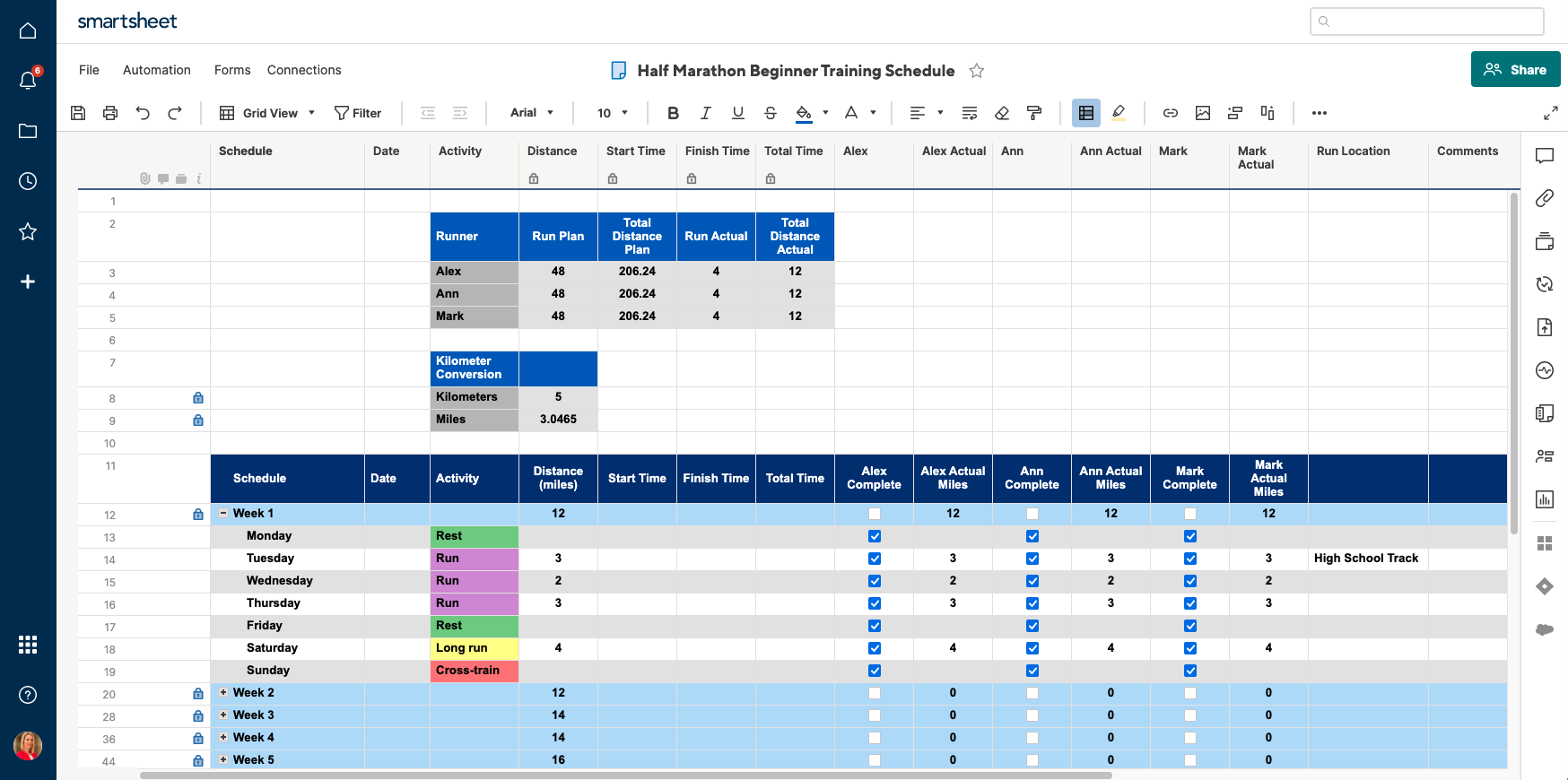Training Takes Time - Start Now With One of Our Marathon Training Plans
Once you’ve picked a race, you should find a training schedule to begin preparing for the event. Although a runner who possesses a good level of fitness may be able to complete a race with very little training, it is not optimal to reduce the risk of injury.
To determine which training schedule will fit your needs, find one that suits your overall fitness, running experience, and race goals. Also, consider that the more time you allow for your training plan, the less rigorous your weekly running schedule will be and the more time you will allow to pace yourself and let your body rest throughout.
Kate French, Technical Customer Support Specialist at Smartsheet, has run multiple half, full, and ultra marathons throughout her running career, and has provided her training schedules for you to use. Of course these schedules are only a suggestion of how you can prepare, so feel free to make adjustments to fit your needs. The provided half marathon training schedules span over 12 weeks, while the full marathon schedules are 18 weeks. You may also decide to adjust the length of these schedules if you feel the mileage increase is too severe or if you have more time until your race.
Note: In order to use the half and full marathon templates, you must sign up for a free, 30-day trial of Smartsheet. There's no credit card required; all you need to do is provide your name and email address.
Half Marathon Training Schedule Templates
Beginner This schedule is intended for anyone who has decided to run a half marathon for the first time. At this point, you should already have a base fitness level with the ability to run 30 minutes, three to four times a week. Additionally, having participated in a 5k, 10k or 12k race prior to this point would be helpful to have experience with racing. Typically, as a first-time half marathoner, you will not be working toward a time or speed goal, but rather should have the goal of simply finishing the race.
Get the Half Marathon Beginner Training Schedule template
Intermediate If you are a runner who is looking to improve your half marathon race performance, this is likely a schedule for you. You should be able to run 30-60 minutes per day, five to seven days a week, and have participated in a few 5k and 10k races. This schedule will focus less on simply crossing the finish line, and more on achieving personal time and speed goals.
Get the Half Marathon Intermediate Training Schedule template
Advanced This training schedule is intended for experienced runners. You should be able to run 30-60 minutes per day, five to seven days a week, and have some knowledge of speed training. Additionally, you will have participated in multiple 5k, 10k, half marathons and full marathons, and are looking to improve your performance.
Get the Half Marathon Advanced Training Schedule template
Walking Participating in a half marathon is not reserved only for runners, walkers can participate, too. If you would like to walk a half marathon, use this training schedule to prepare for race day. Prior to beginning this training, you should be able to walk 30 minutes a day, three to four times a week. No previous race experience is necessary, but it wouldn’t hurt to walk a few 5k or 10k races leading up. Also, a reasonably fit person should be able to walk a half marathon in approximately four hours. So understand the time commitment involved in training to walk a half marathon.
Marathon Training Schedule Templates
Beginner Although this training schedule is labeled as beginner, the beginner runner preparing to run a marathon should have approximately a year’s worth of running experience. Additionally, you should be comfortable running distances of three to six miles and should be training five to six days a week. Your experience should also include participating in the occasional 5k and half marathons. Similar to the half marathon training schedule, this plan is to help you finish the race and does not focus on speed or time.
Get the Marathon Beginner Training Schedule template
Intermediate Similar to the intermediate half marathon training program, this training schedule is focused on improving your performance more than simply crossing the finish line. If you chose this schedule, you are likely able to run longer distances and want to increase your speed. Within your first training week, you will run 10 miles, so you should be comfortable running six to eight miles and be training five to six days a week. This training schedule also switches out cross-training during the week for another long run that you will run at marathon pace.
Get the Marathon IntermediateTraining Schedule template
Advanced This training schedule is a fairly difficult training plan. Like the other levels, you will progress in distance, but your first week starts out with a 10-mile long run, and you will peak at running three 20-mile long runs. Additionally, this workout will consist of a combination of hill runs, tempo runs, and interval training throughout the schedule. With the right mindset, anyone is capable of using this training schedule; however, if this is your first marathon, you should likely start with the beginner training schedule with a goal of simply finishing.
6 Key Features a Training Schedule Needs to Help You Stay on Track
There are many training schedules out there, and realistically they are all quite similar. It’s important to find a schedule that will not only layout a plan for you but will also help you track your progress along the way. We’ve compiled a list of key features your training schedule should include to help ensure you complete the appropriate amount of training and make it across the finish line.
1. Stay on Track With Daily Reminders: When you’re in the middle of training for a marathon, it is easy to forget which workout you are on. Be sure your training schedule has the ability to send you daily reminders that include the workout details. Daily reminders are helpful to not only know which training day it is, but also to keep the training as top of mind and help you stay in the right mindset.
2. Organize Training Details With Hierarchy: Most training schedules are formatted very similarly - a simple table with weeks, days, activities and distances listed. Although this layout is common, it can seem cluttered and a bit clunky when trying to determine the activity for a specific day. Use a training schedule that allows you to use hierarchy to organize the details. With a layout that includes hierarchy, you can open specific weeks to quickly identify daily trainings and minimize other weeks that are complete or upcoming.
3. Keep Up With Distance Goals Using a Conversion Calculator: Many races are measured in kilometers like 5k, 10k and 12k races, but the training schedules are often in miles. Ensure your training schedule solution has a distance conversion calculator to quickly determine how many miles you need to run to hit specific distance goals.
4. Increase Accountability By Sharing Your Schedule: Deciding to train for a marathon is a huge undertaking and inevitably there will be days that you just do not want to train. Having the support of your friends and family is important to keep you on track. Finding a group of friends to train with can not only be fun, but may also help to keep you motivated. Additionally, by telling people of your goal to run a marathon, you are less likely to quit altogether because you now have people who will provide a bit of clear pressure and hold you accountable to achieve your goal. Find a training schedule tool that enables you to share your plan with others to increase transparency and keep track of each other's’ progress.
5. Access Your Schedule Anywhere, Anytime: Although you have decided to take on the challenge of running a marathon, you likely also have a regular life that includes a job, family, kids and more, meaning you need to be creative when fitting in your weekly runs. Perhaps you have to go for a run during your lunch hour, or run around the track while your kids are at soccer practice. That being said, the ability to access your training schedule anywhere and at anytime is important to help you keep up with your training goals.
6. Use Dashboards and Reporting to Track Overall Progress: As you advance through your preparation, you will likely make significant accomplishments in the distances you complete or times you run. Use a training schedule solution that allows you to roll up important details like run, distance or time goals, and compare them to the actual amounts you’ve completed. Additionally, with certain tools, you can set up reports to automatically be sent to you and your accountability team to keep you motivated and aware of your progress.
Choosing the Best Training Schedule
Preparing for and running a marathon is a huge commitment, and having a training schedule is important to help you stay on track. Be sure to choose a training schedule that clearly lists your daily distance and goals. Also, find one that you can access from anywhere and share with your family and friends to keep you accountable. With the right training schedule and these helpful features, you will be well on track to successfully crossing the finish line on your next marathon.
See firsthand how helpful a marathon training schedule template can be in Smartsheet.
For more pre-built training templates and helpful project management tips, visit our Resources page.


